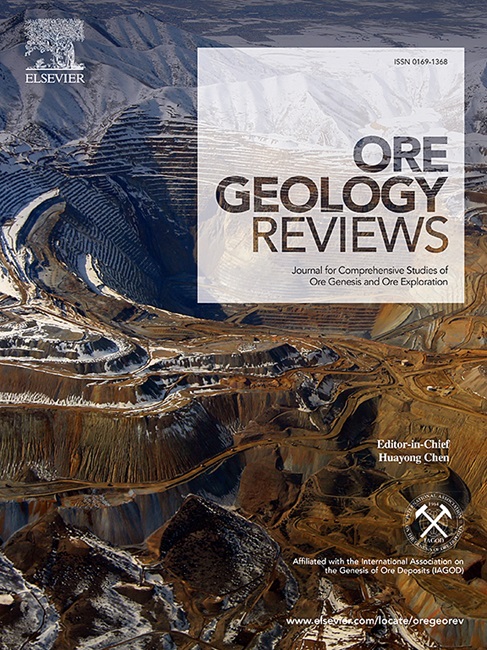Distribution of tellurium, selenium, cobalt and gold in sulfide minerals: A case study of the Jiguanzui porphyry-skarn Au-Cu deposit, Eastern China
IF 3.2
2区 地球科学
Q1 GEOLOGY
引用次数: 0
Abstract
In recent years, an increasing number of studies have reported the enrichment of Te, Se, and Co in magmatic-hydrothermal deposits in the Mid-Lower Yangtze River metallogenic belt (MLYRB), especially in Au-rich deposits. The Jiguanzui deposit, a representative porphyry-skarn Au-Cu deposit in the MLYRB, Eastern China, is characterized by significant critical metal (Te, Se, Co) association. Based on previous studies on critical metals distribution, this study presents trace element geochemistry of various sulfide minerals (chalcopyrite, bornite, sphalerite, molybdenite) through LA-ICP-MS analysis, aiming to reveal the distribution and modes of occurrences of Te, Se, Co, and Au among sulfide minerals in the Jiguanzui Au-Cu deposit. Analytical results indicate that, except for molybdenite, which hosts high concentrations of both Te and Se, pyrite and chalcopyrite generally have higher Te contents than bornite and sphalerite, whereas bornite and chalcopyrite exhibit relatively high Se concentrations. Cobalt and Au are dominantly hosted in pyrite and chalcopyrite, respectively, although the highest Au concentration up to 14 ppm was tested in pyrite. Principal component analysis of trace element contents, time-resolved LA-ICP-MS signal depth profiles, and trace element correlations suggest that Te is generally incorporated as silver and bismuth telluride mineral inclusions in the sulfides, whereas Se and Co are incorporated into the lattice of sulfide minerals. The intimate Pb-Bi-(Cu)-Au associations suggest that tiny mineral inclusions of native Au coexisting with either Cu-Bi sulfosalts or Pb sulfides or sulfosalts. Comparative analysis of the distribution patterns of Te, Se, Co, and Au in porphyry-skarn deposits within the MLYRB suggest that pyrite is the main Te-hosting sulfide mineral, whereas chalcopyrite is the major host for Se, which means Te hosted in pyrite is difficult to recover under current technologies. Pyrite and sphalerite are the major hosts of Co, and chalcopyrite is the main Au-bearing sulfide mineral in the deposits.

碲、硒、钴和金在硫化物矿物中的分布:中国东部鸡冠嘴斑岩-矽卡岩金-铜矿床案例研究
近年来,越来越多的研究报道了长江中下游成矿带(MLYRB)岩浆-热液矿床中Te、Se和Co的富集,尤其是在富金矿床中。鸡冠嘴矿床是中国东部长江中下游成矿带具有代表性的斑岩-矽卡岩型金-铜矿床,其特征是临界金属(Te、Se、Co)关联显著。在前人对临界金属分布研究的基础上,本研究通过LA-ICP-MS分析,对各种硫化物矿物(黄铜矿、辉铜矿、闪锌矿、辉钼矿)进行了微量元素地球化学分析,旨在揭示鸡冠嘴金铜矿中Te、Se、Co、Au在硫化物矿物中的分布和出现模式。分析结果表明,除辉钼矿同时富含高浓度的 Te 和 Se 外,黄铁矿和黄铜矿的 Te 含量普遍高于辉铜矿和闪锌矿,而辉铜矿和黄铜矿的 Se 含量相对较高。钴和金分别主要赋存于黄铁矿和黄铜矿中,但黄铁矿中的金含量最高,达到 14 ppm。痕量元素含量的主成分分析、时间分辨 LA-ICP-MS 信号深度剖面和痕量元素相关性表明,碲一般以银和铋碲化物矿物包裹体的形式被包裹在硫化物中,而硒和钴则被包裹在硫化物矿物的晶格中。铅-铋-(铜)-金的密切关联表明,原生金的微小矿物包裹体与铜-铋硫化物或铅硫化物或硫化物共存。对MLYRB地区斑岩-矽卡岩矿床中的铁、硒、钴和金分布模式的比较分析表明,黄铁矿是主要的碲寄生硫化矿物,而黄铜矿是硒的主要寄生矿物,这意味着黄铁矿中的碲在现有技术条件下难以回收。黄铁矿和闪锌矿是钴的主要矿床,黄铜矿是矿床中主要的含金硫化矿物。
本文章由计算机程序翻译,如有差异,请以英文原文为准。
求助全文
约1分钟内获得全文
求助全文
来源期刊

Ore Geology Reviews
地学-地质学
CiteScore
6.50
自引率
27.30%
发文量
546
审稿时长
22.9 weeks
期刊介绍:
Ore Geology Reviews aims to familiarize all earth scientists with recent advances in a number of interconnected disciplines related to the study of, and search for, ore deposits. The reviews range from brief to longer contributions, but the journal preferentially publishes manuscripts that fill the niche between the commonly shorter journal articles and the comprehensive book coverages, and thus has a special appeal to many authors and readers.
 求助内容:
求助内容: 应助结果提醒方式:
应助结果提醒方式:


